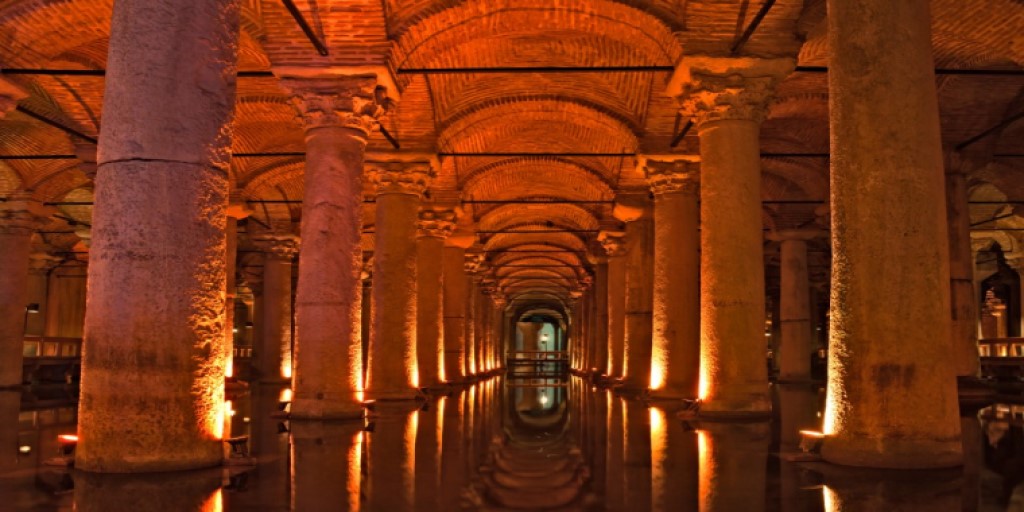Underground Basilica Cistern – Istanbul Turkey
Basilica Cistern or Yerebatan Palace is located in Istanbul’s Sultanahmet district. It was built under the Stoa Basilica, which was built as a center of commerce, justice and art between the 3rd and 4th centuries.
First constructed by Emperor Constantine, the small building was rebuilt by Emperor Justinian in the 6th century due to the corruption of the city during the uprisings in 532.
Because all the waters around Istanbul were salt water, the Basilica Cistern served filtered drinking water to the Great Palace and the buildings around it. 1453 after the conquest of Istanbul by the Ottoman Empire, water was also supplied to Topkapi Palace. 4 day Istanbul Tours

Mark Twain wrote…
“We visited the Thousand and One Columns. I do not know what it was originally intended for, but they said it was built for a reservoir. It is situated in the centre of Constantinople. You go down a flight of stone steps in the middle of a barren place, and there you are. You are forty feet underground, and in the midst of a perfect wilderness of tall, slender, granite columns, of Byzantine architecture. Stand where you would, or change your position as often as you pleased, you were always a centre from which radiated a dozen long archways and colonnades that lost themselves in distance and the sombre twilight of the place.” Istanbul, Turkey
James Bond and Robert Langdon about the Basilica Cistern
Likewise, the dashing and handsome British spy, James Bond took a boat ride through the masses of stone columns in the film “From Russia with Love.” All it was real apart except for the fact that it is not under the Russian consulate.
In 2013, the famous and popular author Dan Brown wrote one of his bestselling novels called Inferno. The climax of the story finishes in the cistern as the main character Robert Langdon mistakenly assumes the stone flight of stairs leads to an underground nightclub. Eventually, his clues lead him back to the cistern and the deadly virus that will wipe out humanity that is hiding in a bag under the water.
In 2015, sources said the Basilica Cistern closed for 4 days to allow director Ron Howard to put the plotline of the Inferno book into one of his spellbinding films featuring Tom Hanks. However, the official website for the Basilica Cistern says filming took place in Budapest instead as there was too much risk of damage.
Features of Basilica Cistern
The Yerebatan Cistern was built by 7,000 slaves in 38 years. It is the largest of 80 cisterns that have existed in Istanbul throughout history.
Medusa is known as the Greek goddess.
It consists of 336 units of 9-meter milk, each with 12 rows of 28 rows.
One of the two Medusa sculpted columns from the Roman period was placed underneath one of them and the other in the opposite direction.
Painted as a vengeful, horrific being with snakes in her hair and a powerful gaze that could turn you to stone, Medusa was bound to a story that depicted her as nothing but a villain.
All the columns and sculptures were brought from unknown Roman cities.
Among these columns, the most striking column is the “Hen’s Eye” column with tears on its surface.
It covers an area of 9,800 square meters. Ewest is 138 meters and 64.6 meters. It has a water capacity of 100,000 cubic meters.
52 steps descend towards the entrance of the cistern.
The water of the cistern is transported via two aqueducts from Belgrade Forest. Valens (Bozdoğan) Arch of 971 meters long and Mağlova Arch of 115 meters long.
Inside the cistern you can see carp fish and metal coins to make a wish.
It was later repaired by Sultan Ahmet III in 1723 and by Abdulhamit II in the 19th century.
The Basilica Cistern was opened to the public on 9 September 1987 as a museum.
The museum is open every day of the week except the first day of some religious holidays. The visit hours are 9:00 – 17:30.
See the best of what this country offers on a that will take you from the West to East.